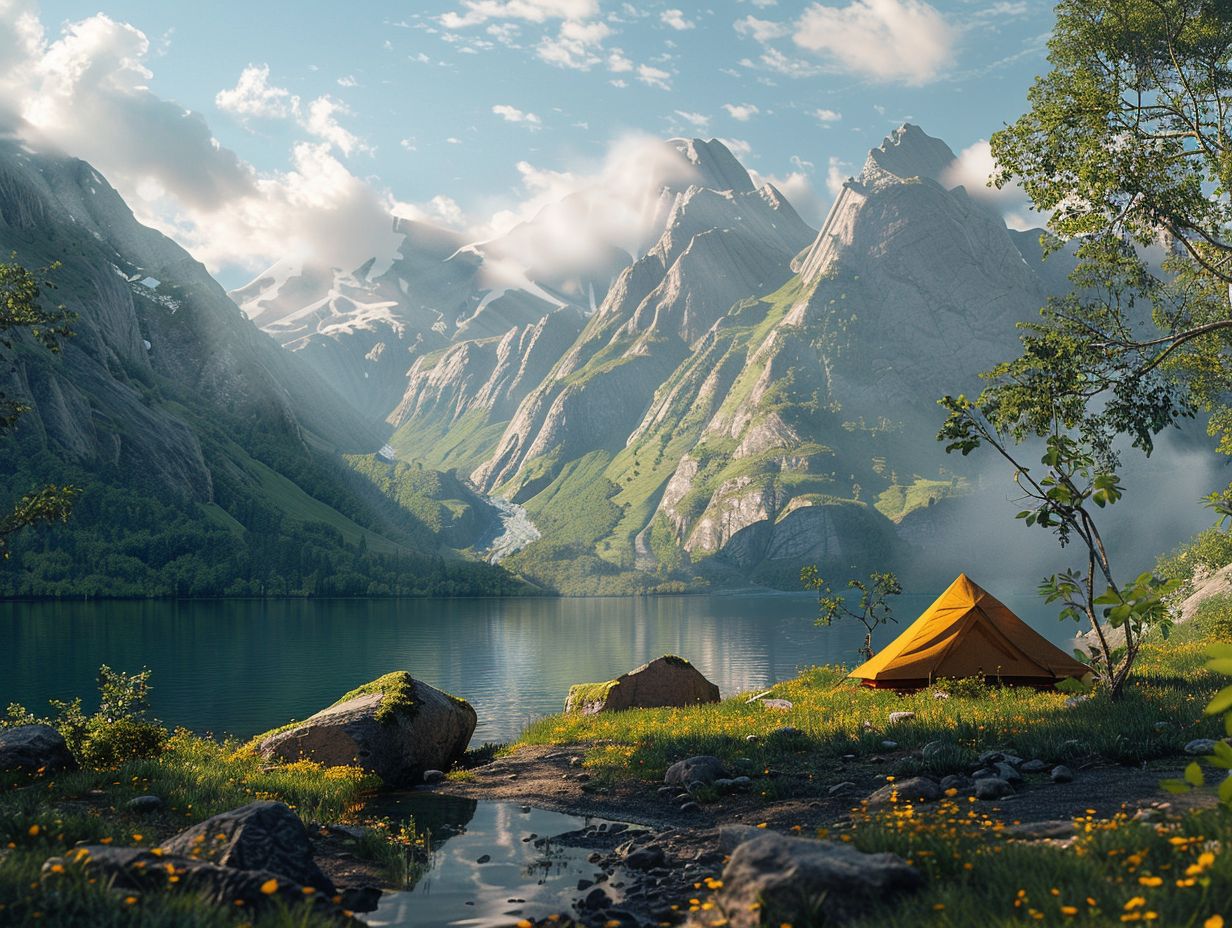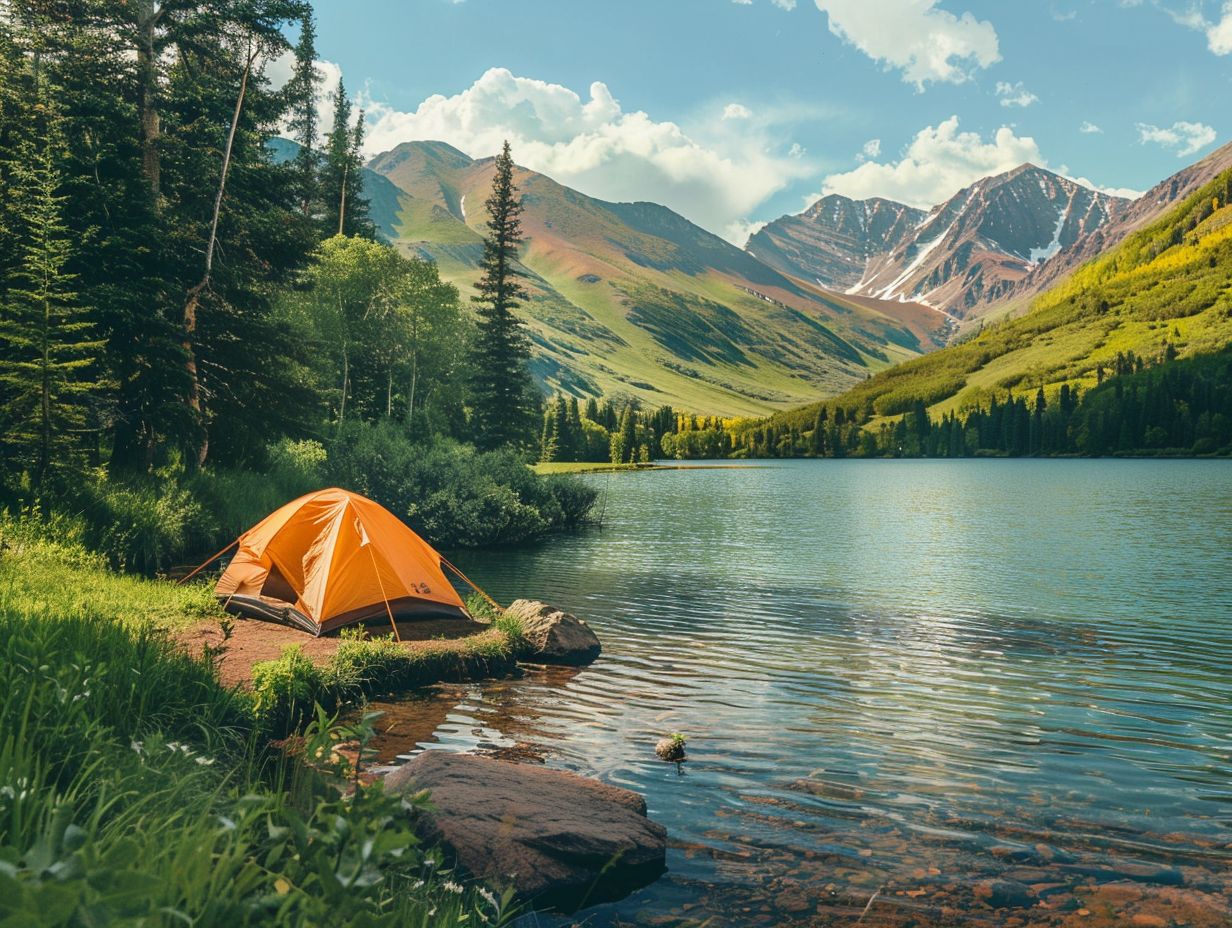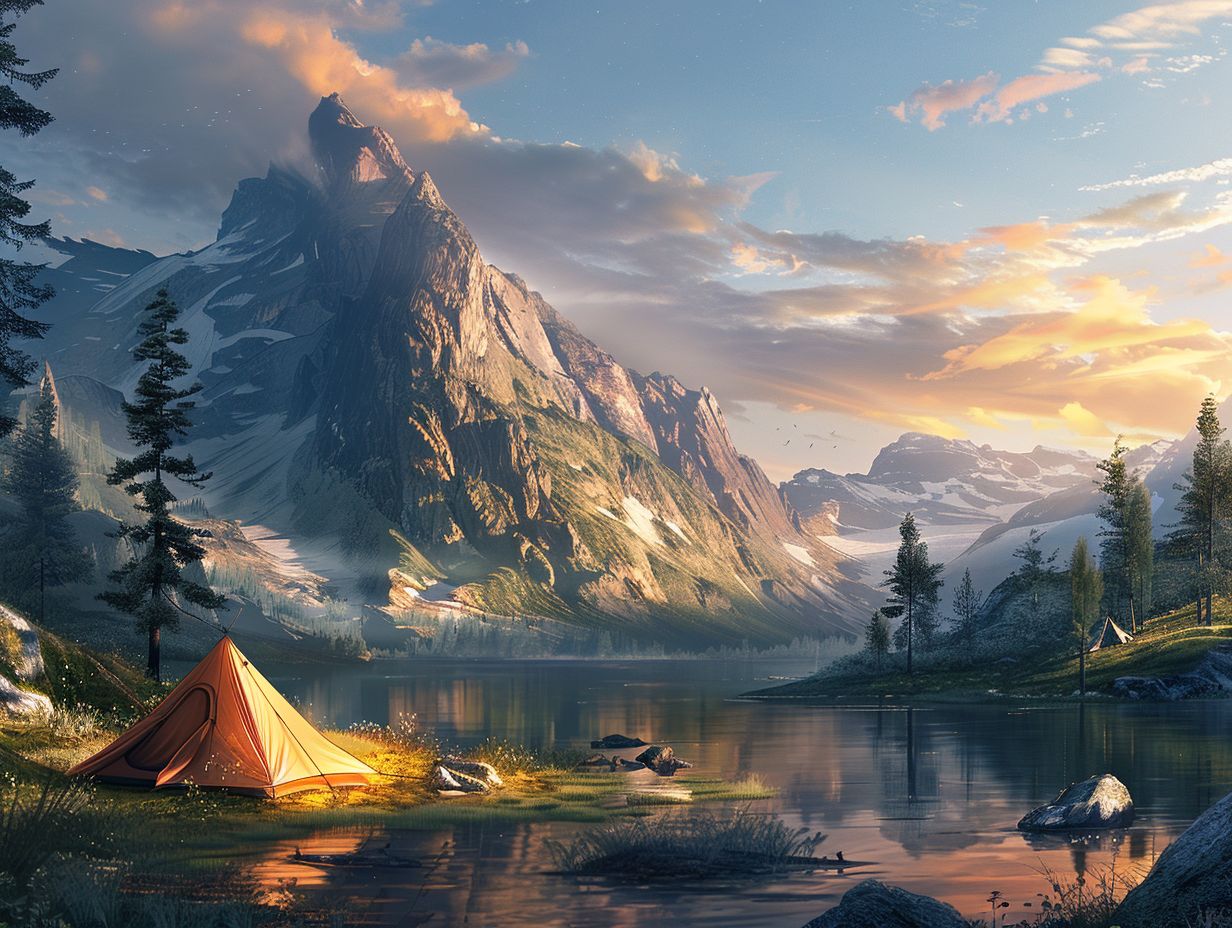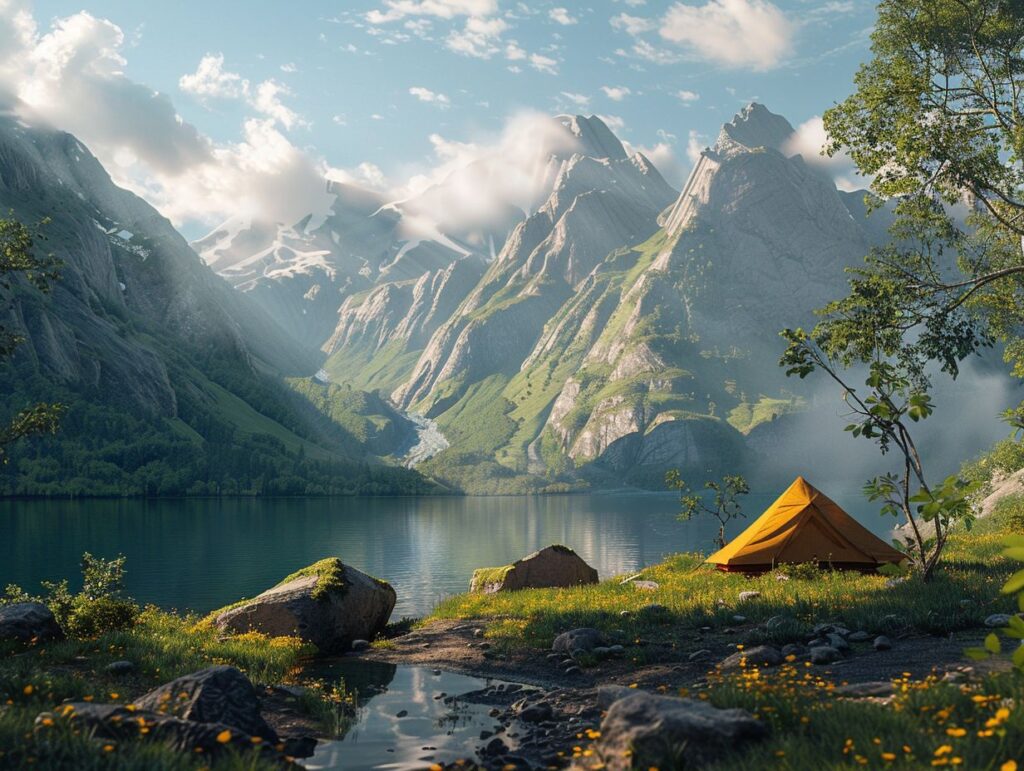Are you ready to embark on your next camping adventure but not sure where to pitch your tent? We share valuable tips and tricks on how to find the perfect campsite.
From researching and planning ahead to setting up a cosy and functional camp kitchen, we’ve got you covered. Avoid common mistakes like choosing a site too close to water or setting up camp in a low-lying area.
Get ready to make the most of your outdoor experience with these expert camping tips!
Key Takeaways:

- Do your research and plan ahead to find the perfect campsite.
- Consider location, accessibility, amenities, restrictions, and safety when choosing a site.
- Pack the right gear, properly set up your camp, and keep your site clean and organized for a successful camping experience.
How to Find the Perfect Campsite: Tips and Tricks
Discovering the ideal campsite requires meticulous research and strategic planning, encompassing a thorough evaluation of factors such as location, accessibility, amenities, and safety considerations, while also adhering to fundamental camping principles like Leave No Trace.
Whether one is venturing into the picturesque trails of Yellowstone, the rugged landscapes of the Pacific Crest Trail, or the verdant expanses of the White Mountains National Forest, online resources like Recreation.gov and Trip Adviser offer invaluable information and reviews to facilitate an well-considered choices process.
1. Research and Plan Ahead
Conducting thorough research and preparing in advance for a camping trip is imperative to secure optimal campsite accommodations, particularly in high-demand locations.
Leveraging online resources like Recreation.gov, Trip Adviser, and Campsited can significantly streamline the task of identifying suitable campsites, perusing reviews, and making reservations. These platforms provide a plethora of insights from fellow campers, aiding in the selection of a site that best suits one’s preferences and needs.
Through strategic planning and the utilization of these tools, individuals can guarantee availability during peak periods and weekends, thereby enhancing the smoothness and enjoyment of their camping venture.
2. Consider the Location and Accessibility
The selection of the campsite’s location and accessibility holds significant importance as they directly influence the overall convenience and satisfaction derived from the camping experience. For individuals who are passionate about outdoor activities, the choice of a campsite that aligns with their preferred pursuits can be transformative.
Imagining being greeted by the awe-inspiring vistas of Yellowstone National Park upon waking from a night spent beneath the stars, ready to begin a day filled with exhilarating hikes, illustrates the impact of a well-chosen campsite.
Conversely, visualising oneself relaxing on the tranquil beaches of Southern California, basking in the sunlight and embracing the laid-back ambience, also highlights the importance of campsite selection.
Whether one is drawn to the rugged allure of New Hampshire’s wilderness or the verdant landscapes of Wales, the proximity of the campsite to hiking trails, water sources, and major roads plays a pivotal role in determining the level of convenience and accessibility throughout the adventure.
3. Look for Nearby Amenities
When one is in the process of selecting a campsite, it is of utmost importance to take into account the presence of nearby amenities such as toilets, water sources, firewood, and facilities tailored for recreational vehicles (RVs).
The provision of clean and well-maintained toilet facilities can have a substantial impact on the overall camping experience, as it garners a feeling of comfort and sanitation among campers.
Access to potable water stands as an essential requirement for various activities including cooking, cleaning, and maintaining proper hydration throughout the camping journey.
The presence of designated campfire areas serves not only to bolster campfire safety measures but also to cultivate a warm and inviting atmosphere conducive to group gatherings.
For individuals utilising RVs, the availability of essential utilities such as electricity and waste disposal facilities like dump stations holds paramount importance in ensuring a seamless and convenient stay.
The availability of these amenities plays a pivotal role in shaping campers’ decisions when it comes to selecting the ideal campsite for their outdoor escapades.
4. Check for Any Restrictions or Permits
Before confirming the selection of a campsite, it is imperative to conduct a review of any restrictions or permits that may be mandated. This process holds considerable importance in guaranteeing an uninterrupted camping experience devoid of unforeseen disruptions. Restrictions pertinent to campsites can vary based on the specific geographical location and time of year.
For instance, certain regions may enforce fire bans during dry seasons to mitigate the risk of wildfires. Rules concerning the protection of wildlife are established to preserve the natural ecosystem and ensure the safety of both campers and indigenous fauna.
Numerous renowned camping locations necessitate the securing of advance reservations through designated platforms such as Recreation.gov, particularly in peak seasons, to reserve accommodations. By comprehending and complying with these regulations, individuals can partake in a camping excursion that is both responsible and pleasurable.
5. Look for a Safe and Secure Site

Ensuring the safety and security of the selected campsite is of utmost importance in order to facilitate a camping experience devoid of concerns.
An essential consideration for campsite safety involves avoiding locations that are prone to flooding, as this can present a substantial risk to both the campsite itself and the general well-being of individuals.
Additionally, it is imperative to conduct a thorough assessment of the surroundings to identify any potential hazards, such as loose branches or unstable terrain. Adequate illumination of the campsite during nighttime is critical to mitigate the occurrence of accidents.
When conducting research and choosing a campsite, it is advisable to seek out reviews or ratings that specifically address the safety and security measures implemented at the site. Furthermore, individuals should contemplate reaching out to the management of the campsite to obtain supplementary details concerning their safety protocols.
6. Choosing a Site Too Close to Water
Selecting a campsite in close proximity to water sources can present notable safety hazards, such as flooding and potential wildlife interactions.
When establishing a campsite near a water source, it is imperative to find a delicate balance between convenience and safety. While having easy access to water for various necessities like cooking, cleaning, and hydration is vital, siting your camp too near the water raises the likelihood of encountering unforeseen risks.
For instance, fluctuations in water levels resulting from rainfall or sudden discharges from upstream dam operations can swiftly transform a tranquil stream into a turbulent body of water, posing a threat to your camping site. Moreover, being in close proximity to water bodies may attract inquisitive wildlife in search of sustenance or refuge, heightening the probability of potentially hazardous encounters.
7. Setting Up Camp in a Low-Lying Area
Establishing a campsite in a low-lying area can expose individuals to the risk of flooding, particularly in periods of heavy precipitation. It is imperative, during the course of a camping expedition, to meticulously ascertain an appropriate elevation and terrain to mitigate potential hazards linked to low-lying camping locations.
The decision to select higher ground can substantially diminish the probability of encountering issues related to flooding and water accumulation. Seek out elevated positions that maintain a safe distance from bodies of water or territories susceptible to overflow.
Take note of the natural drainage patterns within the vicinity to ensure the diversion of water away from the designated camping area. By opting for a site that is elevated and well-drained, one can optimise the safety and comfort levels of their camping endeavour.
8. Ignoring the Terrain and Vegetation
Failure to consider the terrain and vegetation of the selected campsite may result in discomfort and potential risks throughout the camping duration.
Before establishing the campsite, it is advisable to conduct a thorough inspection of the surroundings. Identify level and sturdy ground that is devoid of jagged rocks and excessive vegetation. Selecting an appropriate location is essential not only for ensuring comfort but also for a proper tent arrangement.
Uneven terrain or protruding rocks can cause sleeping challenges and potentially harm the tent structure. By securing a suitable camping spot, individuals can establish a safe and enjoyable setting for their camping expedition.
9. Not Checking for Potential Hazards
Failure to conduct a comprehensive assessment of potential hazards at the campsite can result in hazardous situations and accidents. One prevalent hazard at the campsite that necessitates caution is the presence of dead trees.
These trees may present a hazard through falling branches or trunks, particularly in windy conditions. Similarly, unstable ground, such as areas susceptible to erosion or landslides, can pose a safety risk.
Additionally, vigilance is necessary to avoid insect nests, such as those inhabited by wasps or ants, as disturbing them could lead to painful stings. To ensure a secure camping experience, it is imperative to perform a thorough site inspection immediately upon arrival.
It is essential to observe any indications of dead trees, assess the stability of the terrain, and identify potential insect nests. By proactively recognising and addressing these risks, the likelihood of accidents during the camping excursion can be significantly reduced.
10. Not Considering the Wind Direction
Failure to take into account the direction of the wind can have a significant impact on the functionality and comfort of your campsite, affecting elements such as the campfire, tent placement, and overall camping experience.
When selecting the location for your tent, it is imperative to consider the influence of the wind on the internal ventilation of the tent, thereby ensuring a pleasant and smoke-free atmosphere.
Properly situating your campfire in accordance with the prevailing wind direction can effectively prevent smoke from being blown directly into the tent. To assess wind patterns, individuals should observe indicators such as the movement of foliage, the direction of smoke emanating from neighbouring campfires, or utilise a compact handheld anemometer.
Moreover, positioning the tent in a downwind direction from the campfire can not only mitigate the impact of smoke but also contribute to a warmer and more inviting camping environment.
11. Bring the Right Gear and Supplies

It is imperative to bring the appropriate gear and supplies to ensure a successful and pleasant camping experience. In the absence of the correct equipment, campers may find themselves inadequately prepared for the challenges of the wilderness. Tents serve as a refuge from the elements, while sleeping bags offer a cosy place for repose.
Cooking utensils facilitate the preparation of delicious meals over an open fire, complemented by firewood for warmth and ambience. Illumination sources such as lanterns or headlamps are vital for traversing the campsite after nightfall. Water purification systems guarantee access to potable water, an essential requirement for any outdoor venture.
The development of a comprehensive checklist is instrumental in ensuring that all camping essentials are accounted for, enhancing both the safety and memorability of the excursion.
12. Set Up a Proper Tent and Sleeping Area
It is imperative to establish a proper tent and sleeping area to ensure comfort and protection from the elements.
To start, it is essential to select a level and dry site for erecting the tent, while avoiding areas prone to water accumulation. Before pitching the tent, it is advisable to clear the ground surface of any rocks or sharp objects that could potentially damage the tent flooring.
Subsequently, after securing the tent, placing a ground sheet beneath it will offer insulation from both cold temperatures and moisture. It is crucial to securely anchor the tent using pegs and tighten all guy ropes to improve its stability during windy conditions. Internally, arranging the sleeping area involves inflating sleeping mats for comfort and setting up sleeping bags to maintain warmth.
13. Create a Cosy and Functional Camp Kitchen
The establishment of a well-organised and practical camp kitchen can significantly enhance the camping experience, ensuring that meal preparation is both enjoyable and efficient.
When arranging your camp kitchen, it is imperative to procure essential cooking amenities such as a portable stove, cookware, utensils, and a chopping board. Opting for compact and lightweight alternatives is advisable to conserve space. Utilising storage containers or bags can be beneficial for maintaining food organisation and safeguarding against outdoor elements.
To fully utilise the available space, it is advantageous to designate specific zones for cooking, food preparation, and clean-up. Adherence to safety protocols, such as utilising a stable surface for cooking and ensuring that flammable items are kept away from the stove, is crucial.
Furthermore, maintaining cleanliness is pivotal; this involves prompt dishwashing, proper disposal of rubbish, and regular sanitisation of surfaces to prevent contamination.
14. Utilise Natural Elements for Shade and Shelter
Utilising natural elements for shade and shelter offers the dual benefit of enhancing comfort and protection from the elements at your campsite. Trees, rocks, and other natural formations can be strategically employed to establish shade and windbreaks within the campsite.
When selecting a location for setting up a tent, identifying existing trees that can offer shade during peak sunlight hours is advisable. Placing the tent behind large rocks or boulders can serve as an effective windbreak, shielding occupants from strong gusts.
The incorporation of these natural elements not only adds to the visual appeal of the campsite but also contributes to temperature regulation and mitigation of adverse weather effects.
15. Keep Your Campsite Clean and Organized
Ensuring cleanliness and organisation within the campsite is imperative for promoting safety, visual appeal, and upholding the Leave No Trace principles.
One effective method for upholding cleanliness at the campsite involves the proper disposal of waste through the utilisation of designated rubbish receptacles or the removal of all rubbish from the site. This practice not only aids in maintaining a litter-free camping area but also plays a role in wildlife conservation by mitigating the risk of animals ingesting hazardous materials.
Furthermore, securely storing food in animal-resistant containers or bear lockers is essential to deter wildlife from being attracted to the campsite. By minimising clutter through the systematic organisation of camping equipment in assigned areas, individuals can optimise space utilisation and facilitate ease of item retrieval when necessary.
Frequently Asked Questions
What are some important factors to consider when searching for the perfect campsite?

Some important factors to consider include location, amenities, accessibility, and weather conditions.
How can I find a campsite that is near my desired activities?
You can use online resources such as campsite directories or apps to search for campsites based on nearby activities or attractions.
What are some tips for finding a campsite with the best views?
Look for campsites on higher ground, on the edge of a lake or river, or near scenic trails. You can also read reviews or call the campground to ask about their best views.
Is it necessary to make reservations for a campsite in advance?
It is recommended to make reservations in advance, especially during peak camping seasons, to ensure availability and avoid disappointment.
How can I find a secluded and private campsite?
Look for campsites that are further away from the main entrance or amenities, or for more remote campsites in national or state parks. You can also try camping during weekdays or off-season to increase your chances of finding a secluded spot.
Are there any safety precautions I should take when choosing a campsite?
It is important to check for potential hazards such as unstable trees or rocks, nearby bodies of water, or potential animal activity. It is also recommended to choose a campsite that is within close proximity to other campers or park rangers in case of emergencies.

